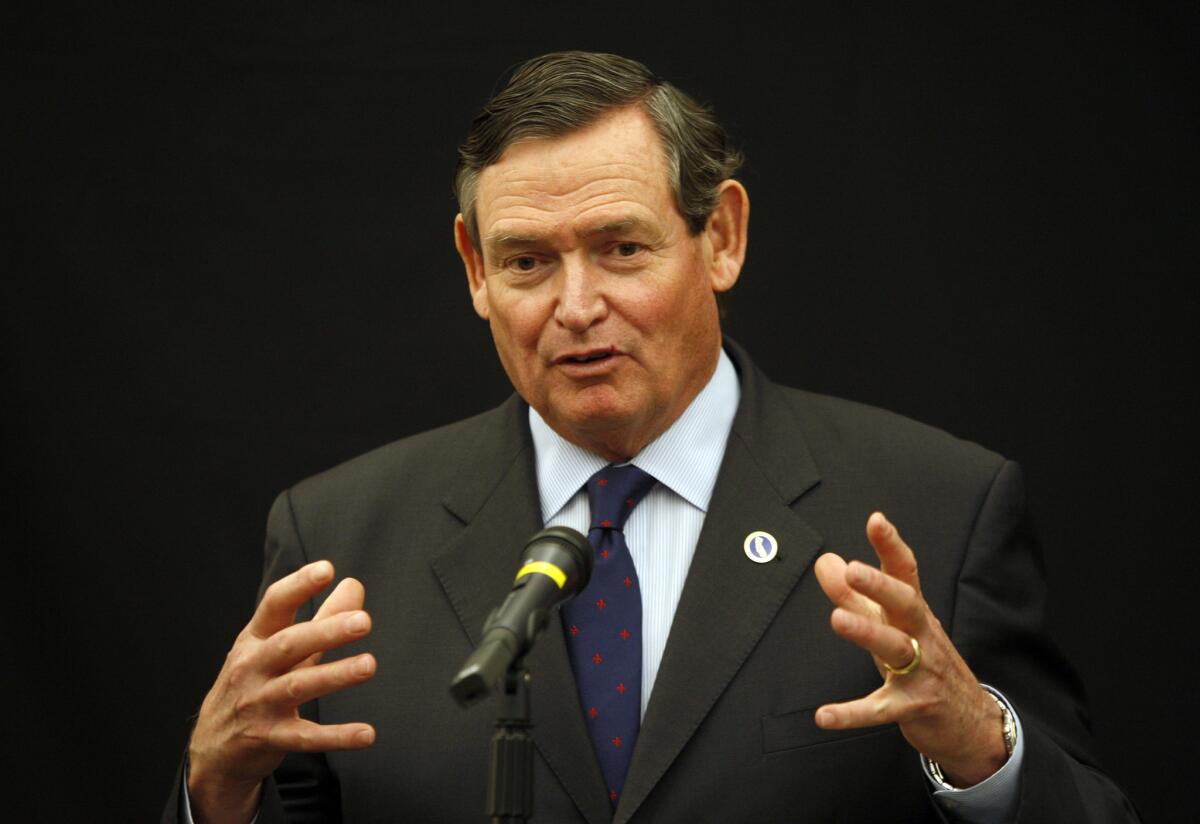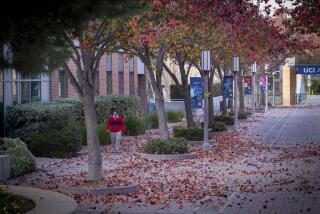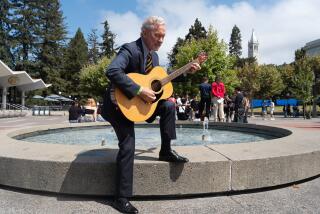Cal State Chancellor Timothy P. White, who aimed for ambitious reforms, announces retirement

California State University Chancellor Timothy P. White, who undertook ambitious reforms to improve student achievement but was criticized at times for budget and policy decisions at the nationâs largest public university system, announced Tuesday that he will retire next year.
White, 70, who became chancellor in 2012, said âthe CSU is strong and stableâ and that his June 30 departure is the right time to step down.
For the record:
2:23 p.m. Nov. 12, 2019This story quotes a Cal State Northridge professor about an increase in failures, drops and withdrawals among black, Latino and low-income students in math and writing. CSUN officials said increased enrollment in the classes has also increased the number of these students who are passing.
The 23-campus system educating 484,000 students âhas a remarkable set of vice chancellors and campus presidents, many of which are new. It has a full board which is engaged and consequential. ... Weâre in a better place financially than weâve ever been,â White said.
His announcement follows that of UC President Janet Napolitano, who plans to resign in August. The two university systems will undertake parallel searches for new leaders over the next several months.
âChancellor White has helped guide the CSU through a period of restoration and ensured that the stateâs renewed investment in the university is repaid by creating opportunity for more students,â said Adam Day, chairman of the Cal State Board of Trustees, said in a statement.
Day said he will name a handful of trustees and an advisory committee to lead the search. The committee will include representatives from the Cal State Academic Senate, California State Student Assn., alumni, staff and campus presidents.
From the boardâs perspective, Day said, that person should be collaborative with faculty and staff and be adept at steering the university during economic downturns. The trustees and advisory committee will present a list of finalists to the full board of trustees, who aim to make a decision in March.
During Whiteâs tenure, the Cal State systemâs general fund allocation from the state grew from $2.3 billion to $3.6 billion, and student enrollment increased from 436,000 to more than 480,000, according to the chancellorâs office.
White has repeatedly cited a ârelentless focusâ on student achievement as his guiding principle. During his tenure the Cal State system developed its Graduation Initiative to boost graduation rates for first-time and transfer students. The initiative also seeks to eliminate differences in degree completion among black, Latino and low-income students by 2025.
Graduation rates and the number of bachelorâs degrees awarded are at all-time highs this year, though progress across campuses and by race and income is uneven.
As part of the initiative, White initiated several controversial policy changes by executive order. In 2017, he revised the general education requirements across all 23 campuses to make them uniform. White also directed the university to revamp how it assessed incoming students and to eliminate remedial education, also called developmental education, non-credit-bearing courses to support students in English and Math.
Faculty across the Cal State system criticized the executive orders saying that they were implemented without adequate consultation and were harmful to low-income and black and Latino students.
âThere was plenty of consultation,â White said Monday. âWhen thereâs lives and careers and cost for students at stake, you canât go year in, year out and deliberate.â
Catherine Nelson, chair of the Cal State academic senate, said she applauded Whiteâs commitment to equity but felt he disregarded the facultyâs voice on key issues, giving them little opportunity for input.
âI think itâs one thing to have a vision,â Nelson said. âI think itâs another to talk about how that vision is implemented. In a university, shared governance is supposed to be part of the process in developing policy.â
At Cal State Northridge, students and faculty last year protested the executive order revising general education requirements over concerns that it would force the elimination of their own ethnic studies course requirement.
Stevie Ruiz, an assistant professor of Chicana/o studies at Cal State Northridge, said the chancellorâs executive orders reflected a lack of attention to the needs of the Cal Stateâs diverse students. Ethnic studies courses were some of the only courses where students saw their own experiences and communities reflected, he said, and students felt âlike it was an attack on their educational achievement.â
Eliminating developmental education, meanwhile, removed an essential support for many low-income, black and Latino students who come from underfunded schools, resulting in a âhuge uptickâ in drops, failures and withdrawals in math and writing, Ruiz said.
The Board of Trustees is debating a similarly controversial policy to require an additional year of âquantitative reasoningâ coursework for incoming freshmen.
White also confronted controversy earlier this year, when a state audit accused Cal State of hoarding a $1.5-billion surplus that it did not properly disclose while threatening to raise tuition without more state funds.
White called the auditorâs findings misleading and unfair. He said Cal State officials had prudently set aside the money as reserves for maintenance and ârainy dayâ funds, and had fully and repeatedly disclosed them.
He is leaving the university at a time when college affordability, studentsâ basic needs and questions of equity remain particularly pressing.
During his tenure, White spearheaded an initiative to study and address food and housing insecurity among students. The study found that roughly 1 in 10 Cal State students were homeless, and 1 in 5 lacked sufficient access to food. Each campus now operates a food pantry or food distribution program, and a majority provide emergency housing.
Increasing diversity among campus leadership was also a top priority for White. When he began as chancellor, only three of the systemâs 23 campuses were led by women â today 12 are women.
Michael Wiafe, president of the California State Studentsâ Assn., said he felt Whiteâs messaging on the importance of diversity and equity had made a difference on campuses.
âIâm a black male,â said Wiafe, a senior at San Diego State. âHaving other black men in positions of leadership at the university ... that serves as a role model that I can see.â
Budget woes dogged White at times, and he had what one labor leader described as a âcontentiousâ relationship with faculty. He narrowly averted a massive strike in 2016 over faculty compensation, agreeing at the eleventh hour to a pay hike. In 2017, he was criticized for approving salary increases for top executives and for raising tuition by 5%, about $270 for in-state students, after a six-year freeze.
Charles Toombs, head of the California Faculty Assn., said White didnât fight hard enough at the state level for more money to enroll more eligible students. Toombs was also critical of Whiteâs hiring practices, saying he didnât hire enough tenure-track faculty.
White, an immigrant from Argentina who was the first in his family to go to college and who attended all three of Californiaâs public higher education systems, said he feels a personal connection to the Cal State system.
âWhen I was a college kid at Fresno in the â60s, I was on food stamps and county-assisted housing. ⌠I feel blessed and honored and quite moved by those opportunities that California provided me,â White said. âAnd it really motivates me because I see myself in our students today.â
More to Read
Sign up for Essential California
The most important California stories and recommendations in your inbox every morning.
You may occasionally receive promotional content from the Los Angeles Times.











